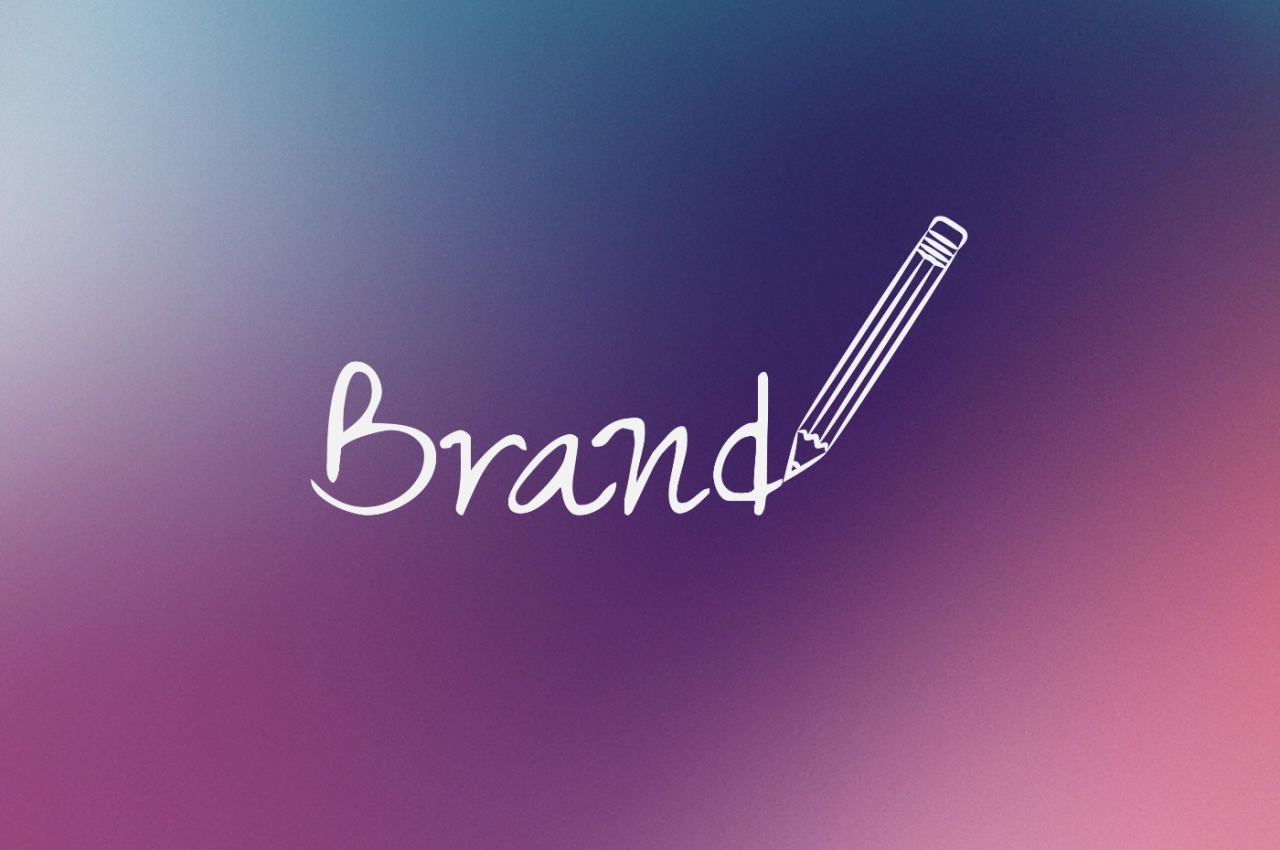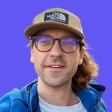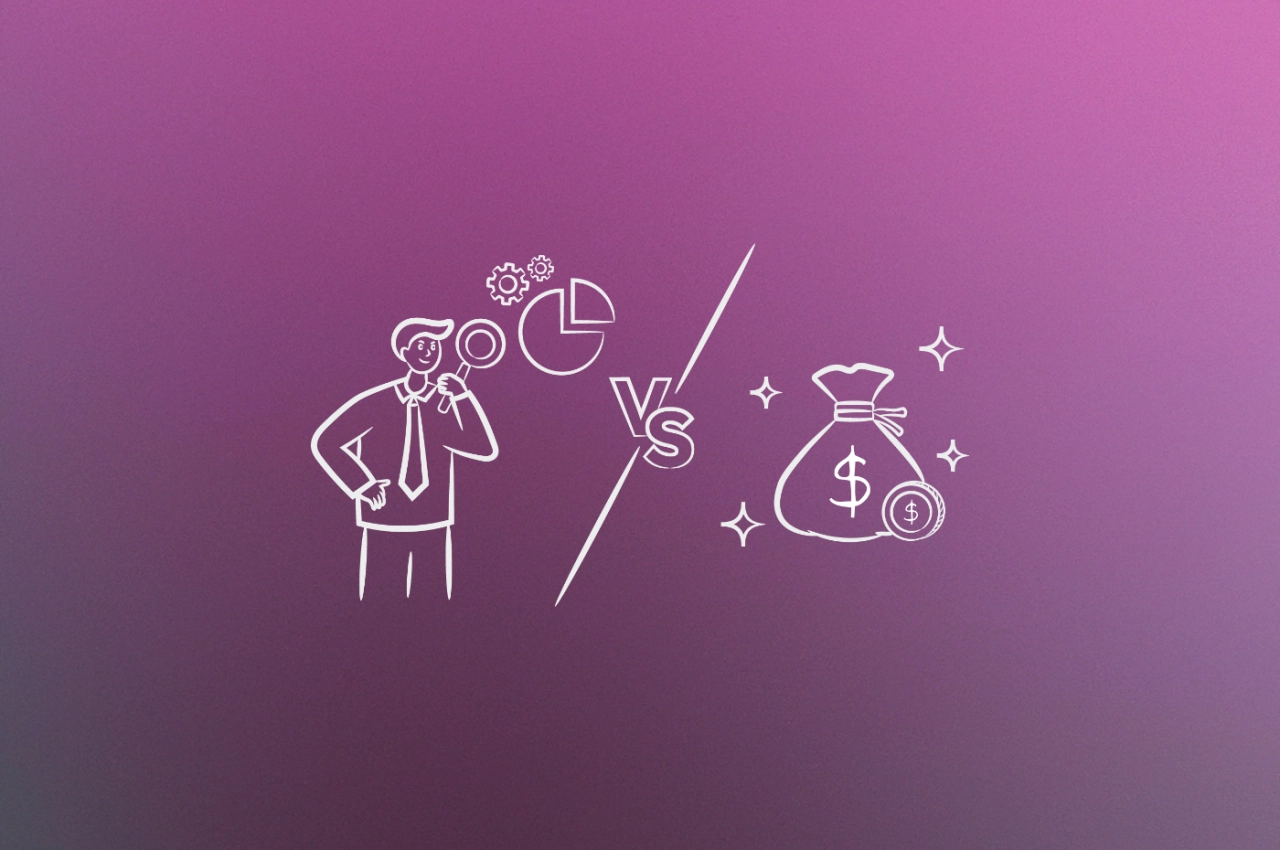- If every prospect pushes back on price, your brand isn’t differentiating you. You’re just another agency competing on cost.
- KlientBoost hired two designers before their first salesperson and hit $1M in 12 months. Most agencies do it backwards, then wonder why they blend in.
- Your brand foundation takes 2–4 weeks if you ship at 80%, and agencies doing $500K–$2M should budget $5K–$10K to see it working in your close rate within 6 months.
People judge by appearances. We can’t change that.
When clients choose between you and a competitor, they judge your website, social profiles, and every touchpoint. Your client’s first interaction with your brand plants a seed that affects the entire relationship.
Yet how many hours have you devoted to your branding in the last 12 months?
Let me guess: not many.
Also, let me guess why: “nobody has time for that,” right?
When most agency owners think this way, we end up with thousands of agencies with similar offerings, similar websites, and similar messaging. The market grows more price sensitive, loyalty disappears, and the need to differentiate skyrockets.
Understanding this topic involves several interconnected concepts:
Each of these concepts plays a crucial role in the overall topic.
Branding isn’t your logo
Let’s clear up the biggest misconception first.
The logo trap
First off, let’s start talking about what a brand is not.
A brand is not your service, your company name or your tagline. It’s not a logo, a color scheme or a catch phrase either.
Most people believe that once you’ve created a logo, you’re done, but that couldn’t be further from the truth.
What branding actually means
Those things matter, but they’re not the brand itself. Your brand is what people actually think and feel when they hear your agency’s name.
It’s the reputation you build through every client interaction. Every proposal you send. Every project you deliver. Every email, every call, every piece of content.
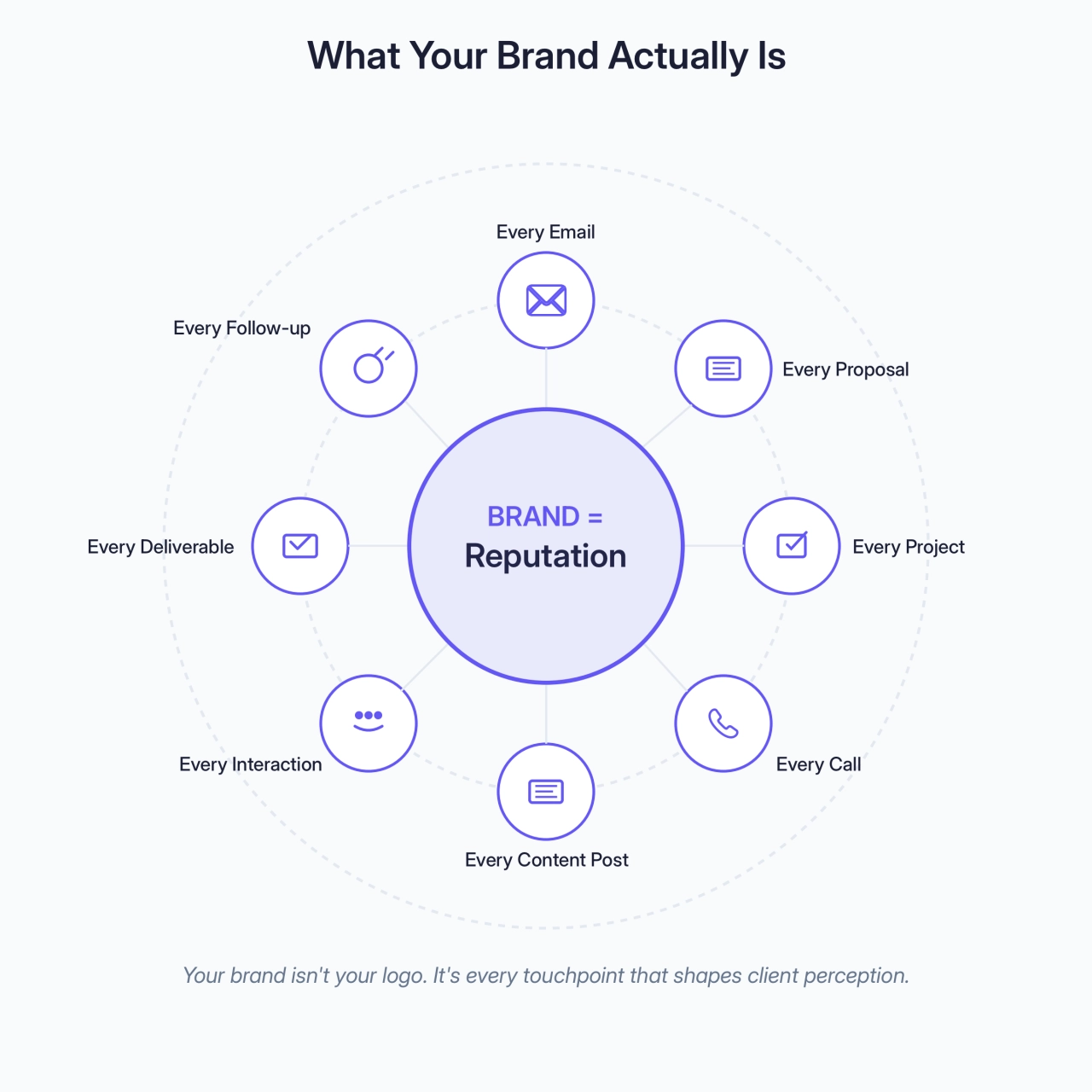
When a prospect is deciding between you and two other agencies, your brand is what tips the scale. It’s why some agencies can charge $10K/month while others struggle to get $2K for the same services.
Blair Enns, founder of Win Without Pitching, puts it simply: “A strong brand is one where you’re not competing on price.”
That’s the test. If every prospect is asking for a discount, your brand isn’t doing its job. If prospects come in already wanting to work with you, it is.
When you keep ignoring your brand
Here’s what you’re up against when you keep pushing branding to someday.

The differentiation problem
It’s gotten so easy to start an agency that clients actually feel relieved when they see you’ve invested in design and branding. It signals you’re serious, not just another freelancer with a business card.
When everyone’s offering similar services at similar price points, your brand becomes the deciding factor. Without a strong brand, getting agency clients becomes purely a price competition.
The business case for investing in your brand
Take KlientBoost, for example. That agency grew from $0 to $1 million in 12 months, and Johnathan Dane, the owner, attributes his success to brand building and design more than I’d like to admit.
Before having a single client, and despite having to pay cash out of his life savings, Dane convinced a designer to join him as the first member.
Bear in mind, we’re talking about a PPC and CRO agency, not branding and design.
That same theme kept coming up. When asked about how his business grew so fast he said, “caring about the brand building and the design of it.”
Would you guess what his second hire was? A project manager? A salesman? Nope, another designer.
What makes up a strong agency brand
Strong brands are five things working together. Here’s what you need.
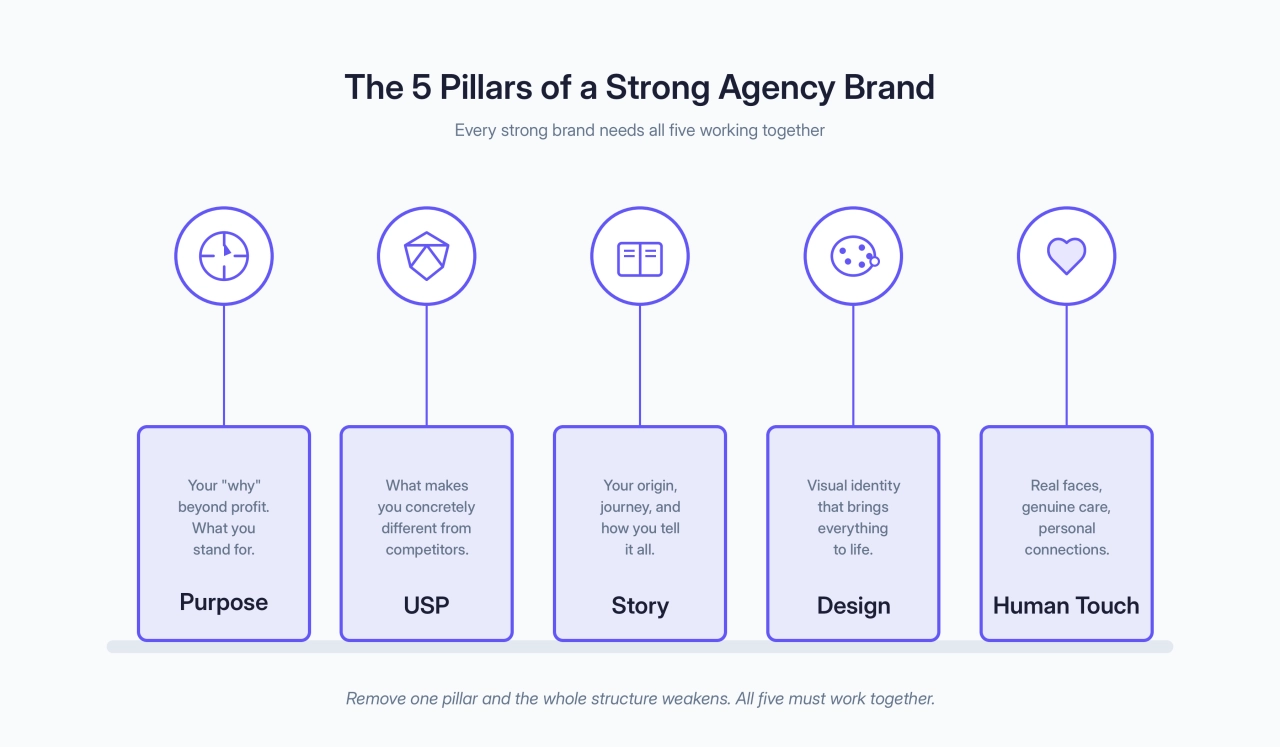
1. Purpose beyond profitability
Every business has profit as its goal, and it should. But when you grow beyond yourself, there needs to be more to it than money.
Simon Sinek’s TED Talk, How Great Leaders Inspire Action, gets at why some organizations inspire people to take action and others just… don’t.
People don’t buy “what” you do, they buy “why” you do it […] The goal is not to do business with everyone who needs what you have, the goal is to do business with people who believe what you believe.
 Simon Sinek,
The Curve
Simon Sinek,
The Curve
Why do you get out of bed every morning? Why did you start your business and how far would you like to take it? More importantly, why should people care?
Being clear about what you stand for differentiates your agency, inspiring action internally (people who work with you) and externally (people who buy from you).
2. Your unique selling proposition
The ’why’ alone can be too high-level for sales conversations. You need something concrete that makes you different.
Here are common USP elements to consider:
Specificity: do you talk to a specific target audience in your messaging and offer?
Reputation: does your agency have a background and a proven track record? Have you worked with well-known brands?
Cost ambiguity: do you show your prices in your website or not?
Specific deliverables: is there something you offer that your competitors don’t, like complementary services?
Pricing model: is your pricing model different? Do you charge a fixed fee while your competitors charge per project, or based on performance?
You can influence some aspects right away, while others take years to develop. The point is, you can’t rely on purpose alone. There needs to be something actually different in your positioning or offer.
3. The story you tell
When you started your business, were you searching for a solution and couldn’t find quality (check out SPP’s story)? Or did people ask you to replicate your success for their business?
People care about origin stories more than you think. But having a story isn’t enough, you need to tell it right.
Take KlientBoost’s origin story, for example.
Johnathan Dane bet his life savings on hiring a designer as his first team member before landing a single client. Most people thought he was crazy. A PPC agency hiring a designer before a salesperson?
But that decision became his brand story. When prospects asked how KlientBoost was different, the answer wasn’t just words on a website. It was “we cared about design and brand building from day one, even when it seemed impractical.”
That story resonated. The agency hit $1 million in 12 months.

Don’t be afraid to get vulnerable and talk about your beginnings. Whether those are humble (no money), selfish (wanted to build a 8-figure agency) or selfless (wanted to help others businesses grow).
In each case, a story will help you build a stronger connection and relatedness with people, making your chances of attracting, converting and retaining more clients higher.
If you take away only one thing from all this information it should be this: how you tell your story matters.
4. Design that brings everything to life
Every visual communication, from a lead magnet cover to content thumbnails and infographics, should remain consistent with your brand, making it identifiable across all channels.
Design is the way an agency’s brand comes to life to represent who you are and what you stand for. This is the execution phase, where all the high-level concepts are turned into actual, high-quality visuals.
If you have an easily-recognizable brand that grabs people’s attention and it can convey your mission and your story then you will stand out. Without question.
5. The human touch
Put human faces in your marketing. Always has worked, always will. It grabs attention, stands out, and connects with people in a way logos never can.
The ultimate purpose of a brand is to humanize a business and what better way to humanize a brand than to, literally, put faces to it. Faces that connect and engage with your customers.
From employee and leadership pictures on your site, to gifts in holidays, to a plain thank you letter every now and then, showing that there’s a human being that truly cares can foster retention within your clientele.
For that purpose, a human touch can always give you that competitive edge you need.
How to build your agency brand
Alright, so you understand the five elements. Now what? Let’s get practical. Here’s how to actually build this thing, step by step.
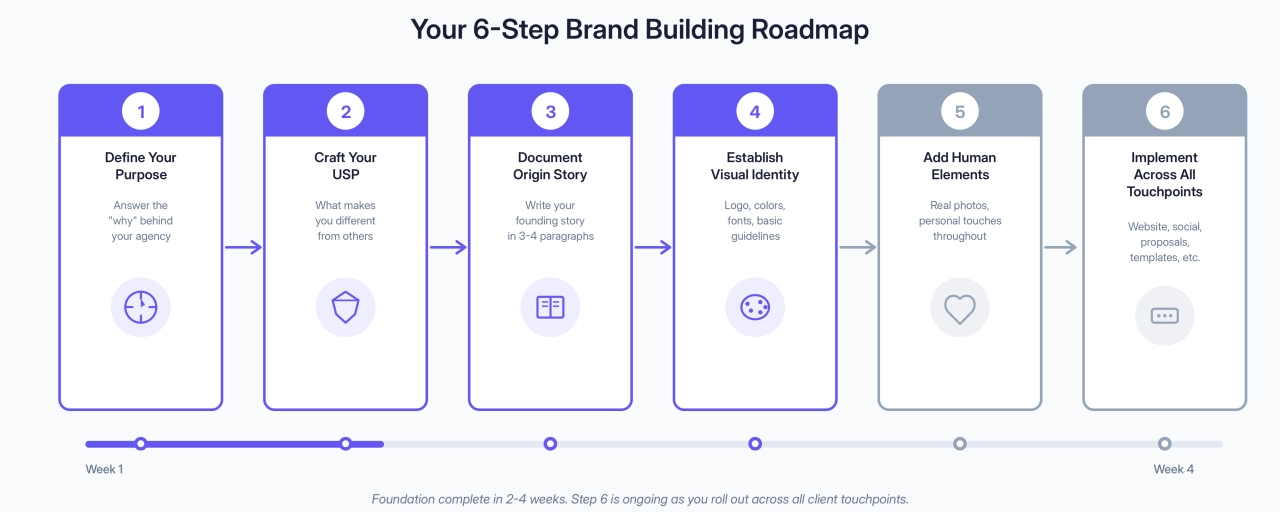
Step 1: define your purpose (the why exercise)
Start by answering these questions honestly:
For yourself:
Why did you really start this agency? (not the sanitized version, the real reason)
What pisses you off about how agencies typically operate?
If money wasn’t a factor, what would you still want to accomplish?
For your team:
What kind of culture do you want to build?
What do you want people to say about working here?
What would make someone stay with you even if a competitor offered more money?
For your clients:
What do you want them to feel when they work with you?
What change do you want to create in their business?
Why should they care that you exist?
Write this down without editing yourself. Look for the common thread because that’s your purpose.
Here’s mine for SPP: I was tired of seeing agency owners struggle with billing because the tools weren’t built for how agencies work. So we built something that was.
Step 2: craft your unique selling proposition
Your USP isn’t about being radically different. It’s about being different enough that someone can explain why they chose you.
Pick 2-3 things from this list that you can own:
Niche specificity: Do you focus on a specific industry? Company size? Type of service? “We do Facebook ads for e-commerce brands doing $500K-$5M in revenue“ is way stronger than “we do Facebook ads.”
Methodology or process: Do you have a specific way you approach projects? A framework? A guarantee? If you’ve been doing this for a while, you probably have processes that work, give them names, document them, make them part of your pitch.
Pricing model: Fixed monthly retainers while everyone else charges project rates? Performance-based while competitors charge hourly? Your pricing structure can be a differentiator.
Team background: All ex-agency founders? Former in-house marketers? Industry veterans? If your team brings specific expertise, that’s worth highlighting.
Service delivery: Done-for-you vs done-with-you? White glove service? Lightning-fast turnaround? How you deliver matters as much as what you deliver.
The goal isn’t to be everything to everyone. It’s to be the obvious choice for the right people.
Write a one-sentence USP that a client could repeat to a friend: “They’re the agency that [your specific thing] for [your specific audience].”
Step 3: document your origin story
This one’s easier than you think because you’ve already lived it.
Answer these questions:
What was the moment you decided to start this agency?
What problem were you trying to solve (for yourself or for clients)?
What obstacles did you face in the beginning?
What almost made you quit?
What kept you going?
What’s different about how you approach things because of what you learned?
The best origin stories have tension. Neil Patel got ripped off by agencies. I struggled with billing systems that weren’t built for subscriptions. Johnathan Dane at KlientBoost bet his life savings on hiring a designer before getting a single client.
Your story doesn’t need to be dramatic. It just needs to be true.
Write it in 3-4 paragraphs. Put it on your About page. Use pieces of it in your pitch decks. Reference it in conversations.
People connect with stories way more than they connect with service lists.
Step 4: establish your visual identity
If you’re starting from scratch, you need at minimum:
a logo (simple is better)
2-3 brand colors
2 fonts (headers and body)
basic usage guidelines
You can get solid work on Dribbble or 99designs for $2K-$5K if you know what you want.
If you already have a logo but everything’s inconsistent (where most agencies are):
create a simple brand guide (even a 5-page PDF)
define your colors and fonts
create templates for proposals, presentations, social posts
make these accessible to your team
Every client touchpoint should feel like it came from the same company: website, proposals, email signatures, social profiles, presentations, case studies. Consistency builds recognition. Recognition builds trust.
Step 5: add human elements throughout
In the age of AI, everyone wants you to be a bit more human.
On your website: Use real photos of your team, not stock. Include names and faces, show your actual workspace, share behind-the-scenes content.
In client interactions: Send handwritten thank-you notes, remember birthdays and anniversaries, send meaningful gifts, check in without a business reason.
In your content: Use “I” and “we” instead of “the agency.” Share personal experiences, include photos of real people doing real work.
The fastest way to stand out? Stop trying to look like a faceless corporation and start acting like the actual people you are.
Step 6: implement across all touchpoints
Do a brand audit of everything your clients see:
Client Journey Stage | Touchpoint | Current State (Be Honest) |
|---|---|---|
Pre-sale | Website | Obvious priority |
Social profiles | Often neglected | |
Email signatures | Usually default Gmail/Outlook | |
Cold outreach emails | Frequently generic templates | |
Discovery call presentations | Sometimes just winging it | |
Proposal stage | Proposal templates | Need consistent branding |
Case studies | Often just Google Docs | |
Pricing sheets | Typically plain spreadsheets | |
Post-sale | Onboarding documents | Usually an afterthought |
Project management tools | Often no branding | |
Reporting templates | Typically generic | |
Invoice emails | Usually default |
The good news? You don’t have to manually enforce all this consistency yourself. Marketing automation tools can help maintain your brand across client communications, from onboarding emails to project updates to invoicing reminders.
The key is setting up templates once, then letting systems handle the repetitive stuff while your team focuses on the custom, high-touch moments where personality matters most. Your brand should be consistent, but that doesn’t mean you need to spend hours formatting every email.
How long does this actually take?
Real talk: If you dedicate focused time, you can get the foundation done in 2–4 weeks.
Here’s how it breaks down:
Phase | Duration | Key Activities | Output |
|---|---|---|---|
Strategy Foundation | 1-2 weeks | Define purpose, craft USP, write origin story, clarify positioning | Brand foundation document with clear positioning |
Visual Identity (New) | 2-3 weeks | Logo design, color palette, typography, basic guidelines | Complete visual brand system |
Visual Identity (Refresh) | 1 week | Refine existing logo, standardize colors/fonts, update templates | Polished and consistent visual identity |
Implementation | 1-2 weeks | Touchpoint audit, create templates, update materials, train team | Launch-ready brand assets across all touchpoints |
Ongoing Refinement | Continuous | Client feedback integration, messaging evolution, asset updates | Evolved brand that grows with your business |
The mistake agencies make is trying to do it all perfectly before launching anything. Get the foundation right, then improve as you go. Your brand will evolve, and that’s fine. What matters is that you start being intentional about it.
Now that you know how to build your brand, let’s talk about the traps that waste your time and money. I’ve seen agencies make these mistakes over and over, so save yourself the headache.
Branding mistakes wasting time and money
Here are the nine biggest ways agencies sabotage their own branding efforts.
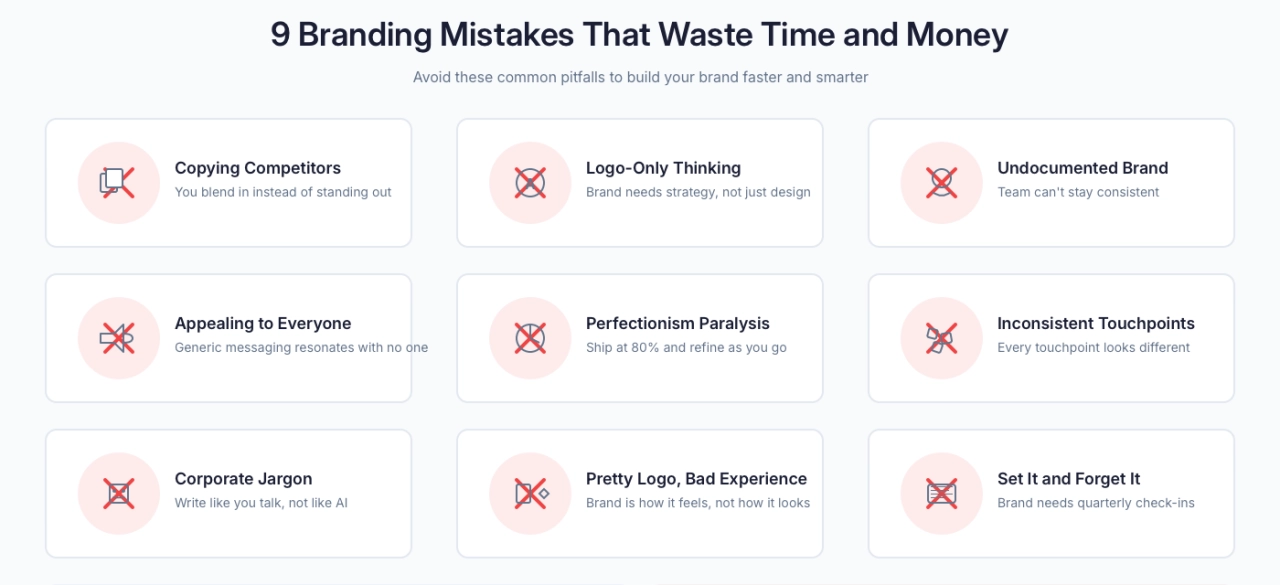
Mistake 1: copying what competitors are doing
You end up with the same color schemes, same stock photos, and same corporate language. It feels safer, but you’re just adding to the noise.
The fix: Start with what makes you genuinely different. What do you believe that others don’t? What do clients say about you that isn’t generic?
Mistake 2: treating branding as a logo project
A new logo without strategy changes nothing. Your proposals, website, and client experience stay the same.
The fix: Before spending on visual design, answer: What do we stand for? Who are we serving? What makes us different? What experience do we want clients to have?
Mistake 3: keeping your brand in your head
No one on your team can articulate it consistently, so your salesperson pitches one version while your PM delivers a different experience.
The fix: Document the basics first, such as purpose paragraph, positioning statement, origin story, visual guidelines, voice examples, key messaging. Put it in a shared document everyone can access.
Mistake 4: trying to appeal to everyone
“We work with all types of businesses” sounds desperate. Generic messaging resonates with no one.
The fix: Pick a lane. Choose an industry, company size, specific problem, or service approach. Your messaging gets way clearer when you know exactly who you’re talking to.
Mistake 5: perfectionism before launch
Six months of tweaking while competitors get clients with good enough brands.
The fix: Ship it at 80%. Get the foundation right (positioning, simple visual identity, basic guidelines, core messaging), then launch and refine based on real feedback.
Mistake 6: ignoring brand consistency
Your website looks professional but your proposals look like Word 2007. Every touchpoint feels like a different company.
The fix: Create templates for your most-used materials, proposals, case studies, presentations, social posts, email signatures, one-pagers, contracts, invoices, reports, and slide decks. Make them easy to access and actually use them. Store them in a shared folder. Enforce it: no proposal goes out unless it follows the template.
Consistency compounds. After six months, you’ll have a recognizable presence. After a year, you’ll stand out in your space.
Mistake 7: sounding like corporate AI
“We empower businesses to leverage innovative solutions that drive transformational growth and unlock unprecedented value.”
What does that even mean?
Why this happens: You think you need to sound professional, so you use big words and corporate jargon. Or worse, you let ChatGPT write your website copy without editing it.
The fix: Read your copy out loud. If you wouldn’t say it to a client in a coffee shop conversation, rewrite it.
Replace:
Leverage → Use
Solutions → Specific thing you actually do
Drive results → What results specifically
Innovative → Delete it, show don’t tell
Empower → Help, enable, or just delete
Write like you talk. Your clients will actually understand what you do.
Mistake 8: forgetting brand is experience
Your website is beautiful. Your logo is slick. But your onboarding is chaotic, your communication is slow, and your deliverables are inconsistent.
Why this happens: You think branding is what things look like, not how they feel.
The fix: Map the entire client journey:
First contact → Response time and tone
Discovery call → Preparation and questions
Proposal → Clarity and confidence
Onboarding → Smoothness and clarity
Project work → Communication and quality
Deliverables → Format and presentation
Follow-up → Proactiveness and care
Your brand is the sum of all these experiences. A beautiful website can’t make up for a terrible client experience.
Fix the experience first. Then make it look good.
Mistake 9: setting it and forgetting it
You do all this brand work in 2024. By 2026, your positioning feels stale, your visuals look dated, and your messaging doesn’t reflect where you’ve grown.
But you never revisit it because “we already did our branding.”
Why this happens: You think branding is a project with an end date. It’s not, it’s ongoing.
The fix: Schedule quarterly brand check-ins:
Is our positioning still true?
Does our messaging reflect our current capabilities?
Are we still targeting the right audience?
Do our visuals feel current?
What’s working? What isn’t?
Make small updates regularly. Every 18-24 months, do a more thorough review. Your business evolves. Your brand should too.
Quick reference: mistakes and solutions
Mistake | The Quick Fix |
|---|---|
Copying competitors | Start with what makes you genuinely different |
Logo-only approach | Define strategy first: purpose, audience, USP |
Brand stays in your head | Document it in a shared doc everyone can access |
Trying to appeal to everyone | Pick a specific niche and own it |
Perfectionism paralysis | Ship at 80% and refine based on feedback |
Inconsistent touchpoints | Create templates, enforce their use |
Corporate AI language | Read it aloud, would you say it over coffee? |
Pretty brand, bad experience | Fix client journey first, then visuals |
Set it and forget it | Quarterly check-ins, big refresh every 18-24 months |
How to know if your branding is actually working
You can’t track brand like conversion rates, but you can tell if it’s working.
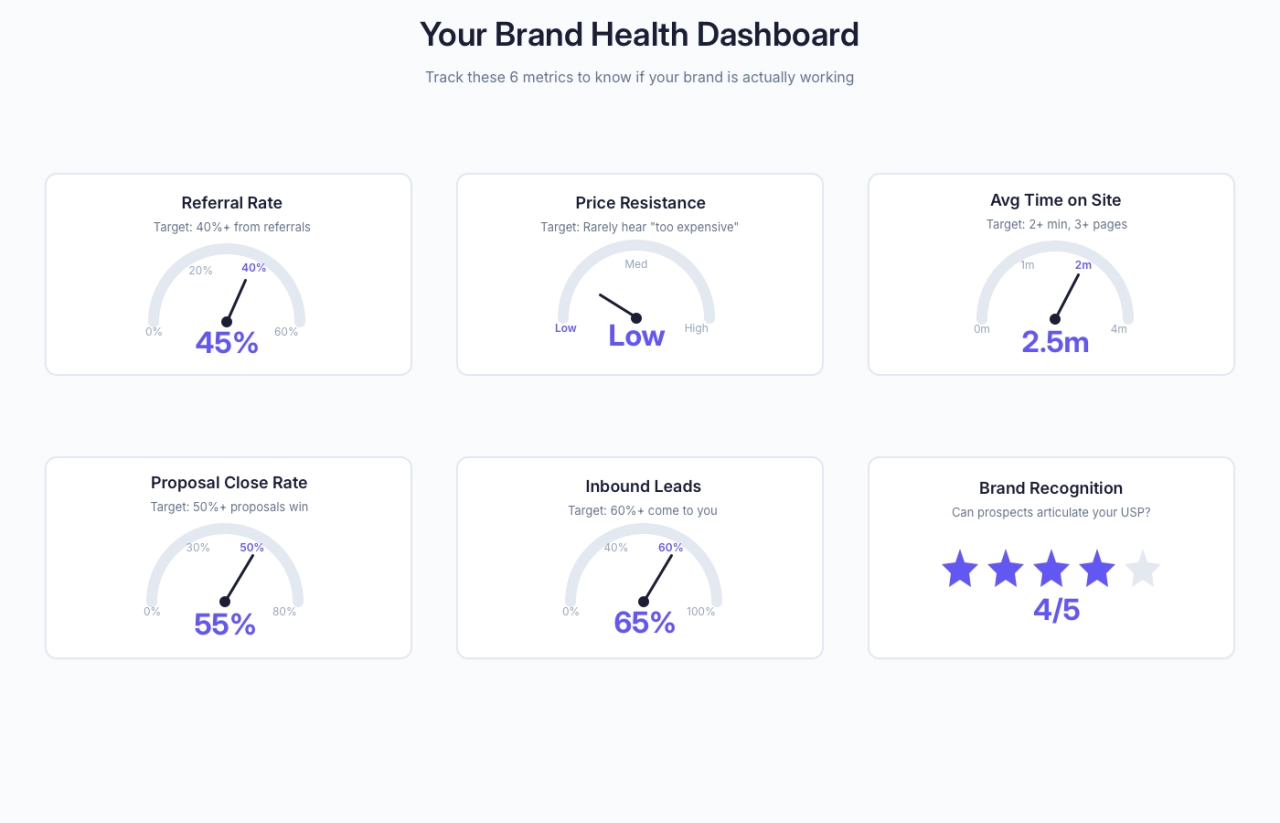
The Metrics That Actually Matter
Write down these six metrics and keep track of them.
1. Referral rate
When clients refer you without being asked, they trust your brand enough to risk their reputation on it.
Track it: What percentage of new clients come from referrals? Under 20% means your brand isn’t doing its job. Over 40% means you’ve built something people want to be associated with.
2. Price resistance
Strong brands charge more because clients aren’t comparing on price alone.
Track it: How often do prospects say you’re too expensive? If you hear it every call, your brand isn’t differentiating you. If prospects rarely push back, your brand is working.
3. Website time and behavior
People spend longer on websites of brands they’re interested in.
Track it: Average time on site and pages per session. If people bounce after 20 seconds, your brand isn’t grabbing them. If they’re clicking through to your About page and case studies, they’re trying to get to know you.
4. Proposal-to-close rate
A strong brand means prospects come half-sold. They want to work with you; they just need to see if the specifics work.
Track it: What percentage of proposals turn into clients? Under 30% means prospects aren’t pre-sold. Above 50% means your brand does heavy lifting before you even write the proposal.
5. Inbound vs outbound split
Brands create pull. The stronger your brand, the more people come to you instead of you chasing them through outbound client acquisition.
Track it: What percentage of new business is inbound? If you’re 90% outbound, your brand isn’t visible enough. If you’re 60%+ inbound, your brand is attracting people.
Now, if you’re looking at those numbers and thinking “great, but how do I actually get more inbound?”, I hear you. Building inbound momentum takes time and consistency. You need content that helps your ideal clients, a presence where they’re already looking for answers, and a clear point of view that makes you memorable.
That’s where inbound marketing strategies come in. The most effective agencies combine strong branding with deliberate inbound tactics. Your brand creates the pull, but inbound strategies give that pull a place to happen.
6. The “How did you hear about us?” Answer
This tells you if your brand is memorable.
Track what prospects say:
I saw your website = not memorable
I was Googling for agencies = not distinctive
A friend recommended you = brand trust
I’ve been following you for months = brand engagement
You’re the agency that [your unique thing] = brand positioning working
If people can articulate why you specifically, your brand is clear.
Your brand measurement dashboard
Here’s your quick-reference guide for tracking brand health:
Metric | How to Track | Strong Performance | What It Reveals |
|---|---|---|---|
Referral Rate | New clients from referrals ÷ Total new clients | 40%+ | Brand trust and client satisfaction strong enough to risk reputation |
Price Resistance | Track objections in sales calls | Rarely hear too expensive | Brand differentiates you beyond price comparison |
Website Engagement | Average time on site, pages per session (Google Analytics) | 2+ min, 3+ pages | Prospects genuinely interested, trying to understand your brand |
Proposal Close Rate | Proposals won ÷ Total proposals sent | 50%+ | Brand pre-sells prospects before you even write proposal |
Inbound vs Outbound | Inbound leads ÷ Total new business | 60%+ inbound | Brand creates pull, prospects seek you out |
“How’d You Hear?” Quality | Track prospect responses when they reach out | “Friend recommended” or “You’re the agency that…” | Brand is memorable and positioned clearly |
The qualitative signals you can’t miss
Numbers tell part of the story. Here are the signals that tell you the rest:
Client language matching yours: When clients start using your terminology, frameworks, or specific phrases, your brand messaging is sticking. This is huge.
Recognition in your space: Are people tagging you in relevant conversations? Asking your take on topics? Inviting you to speak? That’s not luck, that’s brand presence.
Team clarity: Can everyone on your team explain who you are and what makes you different in under 30 seconds? If not, your brand isn’t clear internally, which means it’s definitely not clear externally.
Competitive positioning: Are you being compared to the right competitors? If prospects lump you in with bottom-tier agencies when you want to be seen as premium, your brand isn’t communicating what you think it is.
What not to obsess over
Some metrics feel important but don’t actually move the needle:
Social media follower count: 5,000 engaged followers who refer clients beat 50,000 passive followers every time.
Brand awareness surveys: Too expensive and too abstract. Track referral rate and inbound traffic instead.
Logo recognition: Unless you’re Nike, this doesn’t matter. People remember experiences, not logos.
Awards and accolades: Nice for your ego, but they rarely move the needle unless your target clients specifically care about them.
How often to check in
Your brand isn’t a one-and-done project. Here’s how often to review it:
Monthly: Track your referral rate, inbound vs outbound split, and proposal-to-close rate. These tell you if your brand is working.
Quarterly: Do a deeper dive into website analytics, team brand clarity check, how clients talk about you, and competitive positioning.
Annually: Full brand audit. Is our positioning still true? Do our visuals represent who we are now? Has our audience or offer evolved?
Time for a bigger refresh (every 18–24 months) when:
your positioning feels stale or doesn’t reflect where you’ve grown
you’re embarrassed by your website or materials
new clients ask “do you do [thing]?” and you’ve been doing it for years
your messaging sounds like everyone else’s
team can’t articulate what makes you different
you’re competing on price more than value
The ROI question everyone asks
You can’t tie revenue directly to brand the way you can with paid ads, but you can look at trends.
Track these three numbers over 12 months after implementing your brand:
referral rate
average deal size
close rate
If all three improve, your brand is working. If none improve, something’s wrong with your strategy or execution.
Frequently asked questions
How do I create a brand identity for my agency?
Don’t start with the logo. Start with strategy: your purpose, target audience, USP, and origin story. Then do the visual stuff: logo, colors, fonts, basic guidelines. Ship it at 80% and refine as you go. Perfection kills momentum.
What are the most common branding mistakes agencies make?
Treating branding as just a logo, trying to appeal to everyone instead of picking a niche, and copying competitors instead of being different. Keeping your brand undocumented and forgetting that brand is the entire client experience, not just visuals.
How much should I budget for agency branding?
Most agencies doing $500K–$2M should budget $5K–$10K for professional work. That gets you a custom website, comprehensive brand guidelines, professional photography, and a complete visual system.
Can you give me examples of successful agency branding?
Backlinko (Brian Dean) built a powerhouse SEO brand by publishing fewer but deeply researched posts with original data, making his content the go-to citation source. NP Digital (Neil Patel) dominated through personal brand first, later becoming synonymous with accessible SEO education, then built the agency around that reputation and trust.
What’s the step-by-step process for building an agency brand?
Strategy first (purpose, audience, USP, story), then visual identity (logo, colors, fonts), then implementation (templates, website, guidelines). The foundation takes about a month of focused work, then you refine based on what resonates.
How long does it take to build brand recognition?
Expect 12–18 months before seeing meaningful results and 24–36 months for strong market recognition. KlientBoost spent 12 months consistently showing up with their brand before hitting $1M in revenue.
Start building your brand today
Here’s the truth: every day you wait, you’re leaving money on the table and making your sales process harder than it needs to be.
But the good news? You already have everything you need to start. Your story, your expertise, your way of doing things, it's all there. You just need to make it visible.
Start with step 1 from this guide. Answer those purpose questions honestly. Document your origin story. Pick your USP elements. Do it messy, do it imperfect, just do it.
Remember: ship at 80%. KlientBoost’s brand evolved over time, but they started somewhere. Your brand will evolve too.
The agencies that stand out don’t have perfect brands. What they did right was deciding to take branding seriously and start building.
Your turn.

